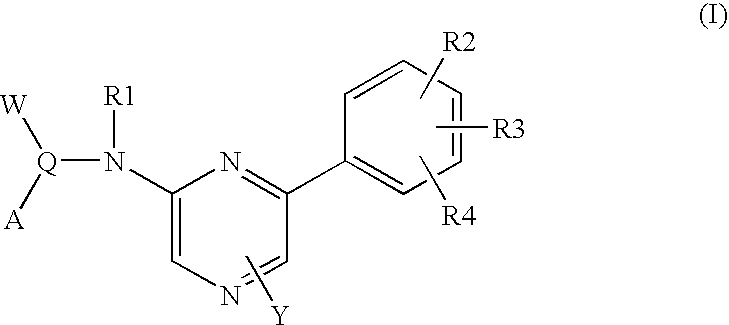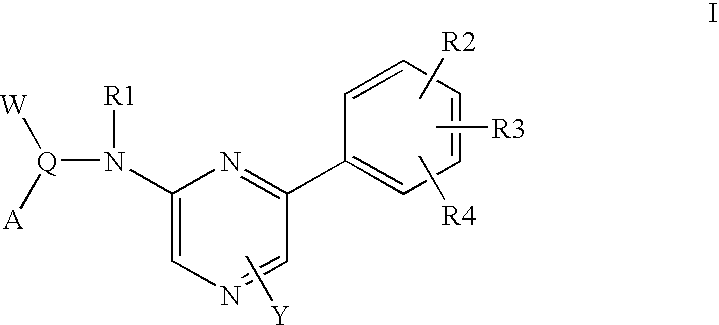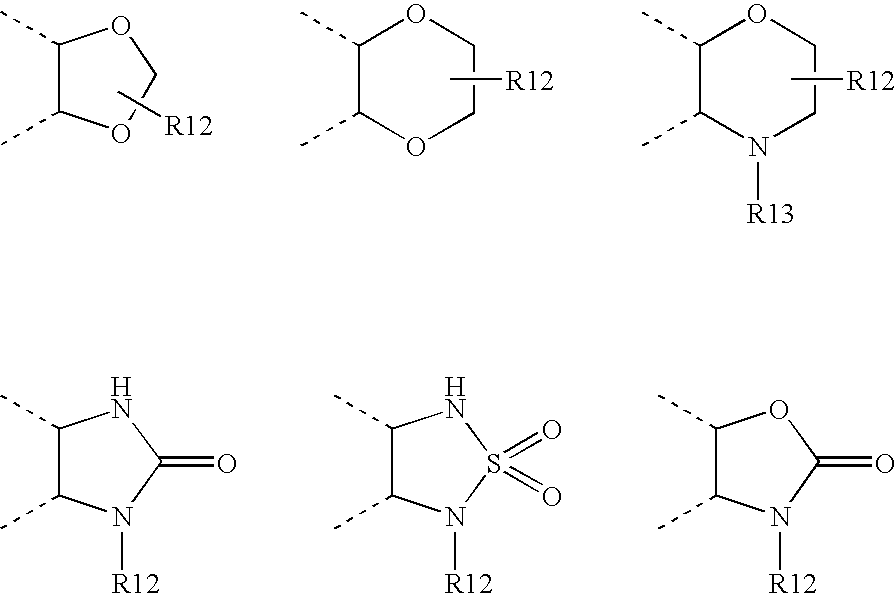Pyrazine-based tubulin inhibitors
a technology of pyrazine and tubulin, which is applied in the field of pyrazine-based tubulin inhibitors, can solve the problem of no general therapeutic cure for psoriasis
- Summary
- Abstract
- Description
- Claims
- Application Information
AI Technical Summary
Benefits of technology
Problems solved by technology
Method used
Image
Examples
example 1
1-[4-(Trifluoromethyl)phenyl]butan-1-ol
[0119]
[0120]A 2M solution of propylmagnesium chloride in ether (4 ml, 8 mmol) was added to a solution of the aldehyde (1.14 g, 6.6 mmol) in dry THF (10 ml) cooled to 0° C. under N2. The mixture was stirred for 16 h at room temperature, after which time saturated ammonium chloride solution was added. The product was extracted into ethyl acetate, and the ethyl acetate layer dried and concentrated to furnish pure product (1.4 g, 98%).
[0121]1H-n.m.r. (CDCl3) δ 0.94 (t, J=7.2 Hz, 3H CH3), 1.41 (m, 2H, CH2), 1.75 (m, CH2, 2H), 4.77 (br s, 1H, CH), 7.44-7.62(m, 4H, ArH)
[0122]Using identical procedures the following compounds were prepared.
[0123]
Compound1H-n.m.r. (CDCl3)δ 0.95(t, J=7.2 Hz, 3H CH3), 1.39(m, 2H, CH2), 1.75(m, CH2, 2H), 4.77(br s, 1H, CH), 7.41-7.63(m, 4H, ArH)δ 0.94(t, J=7.2 Hz, 3H CH3), 1.40(m, 2H, CH2), 1.76(m, CH2, 2H), 2.36(s, 3H, CH3—Ar), 4.65(m, 1H, CH), 7.07-7.28(m, 4H, ArH)δ 0.93(t, 3H, J=7.2 Hz, CH3), 1.37(m, 2H, CH2), 1.75(m, C...
example 2
1-(1-Azidobutyl)-4-(trifluoromethyl)benzene
[0124]
[0125]A solution of 1-[4-(trifluoromethyl)phenyl]butan-1-ol (1.4 , 6.4 mmol) and diphenylphosphoryl azide (2.8 ml, 12.8 mmol) in THF (6 mL) cooled to −10° C. under N2 was treated with DBU (1.9 mL, 12.8 mmol). The resulting solution was stirred at room temperature for 20 hours and then diluted with a mixture of ether and H2O. The organic phase was dried and concentrated and the residue purified by column chromatography using hexane:diethyl ethyl acetate (10:1) as eluent to furnish pure azide (0.85 g, 54%).
[0126]1H-n.m.r. (CDCl3) δ 0.94 (t, J=7.2 Hz, 3H CH3), 1.37 (m, 2H, CH2), 1.75 (m, 2H, CH2), 4.50 (t, 1H, CH), 7.42 (d, J=7.8 Hz, 2H, ArH), 7.64 (d, J=7.8 Hz, 2H, ArH)
[0127]Using identical procedures the following compounds were prepared.
[0128]
Compound1H-n.m.r. (CDCl3)δ 0.94(t, J=7.4 Hz, 3H CH3), 1.38(m, 2H, CH2), 1.76(m, 2H, CH2), 4.50(t, J=7.4 Hz, 1H, CH), 7.48-7.61(m, 4H, ArH)δ 0.93(t, J=7.2 Hz, 3H, CH3), 1.36(m, 2H, CH2), 1.76(m, 2...
example 3
1-[4-(Trifluoromethyl)phenyl]butan-1-amine
[0129]
[0130]A mixture of 1-(1-azidobutyl)-(trifluoromethyl)benzene (0.84 g, 3.5 mmol) and triphenylphosphine (1.8 g, 6.9 mmol) in ethyl acetate (6 mL) and 10% HCl (6 ml) was stirred at room temperature for 64 h. The aqueous phase was collected and the organic phase extracted with 10% HCl (3×5 mL). The aqueous layers were combined and basified with 5M NaOH, and then extracted with ethyl acetate (5×15 mL). The organic phase was dried and concentrated to give pure amine (0.4 g, 54%).
[0131]1H-n.m.r. (CDCl3) δ 0.91 (t, J=7.4 Hz, 3H CH3), 1.31 (m, 2H, CH2), 1.62 (m, 2H, CH2), 3.97 (m, 1H, CH), 7.43 (dd, 2H, Ar—H), 7.58 (dd, 2H, Ar—H)
[0132]Using similar procedures the following compounds were prepared.
[0133]
Compound1H-n.m.r. (CDCl3)δ 0.91(t, J=7.4 Hz, 3H CH3), 1.29(m, 2H, CH2), 1.63(m, 2H, CH2), 3.98(m, 1H, CH), 7.42-7.59(m, 4H, Ar—H)δ 0.91(t, J=6.8 Hz, 3H CH3), 1.31(m, 2H, CH2), 1.62(m, 2H, CH2), 2.35(s, 3H, CH3—Ar), 3.84(m, 1H, CH), 7.03-7.21(m, ...
PUM
| Property | Measurement | Unit |
|---|---|---|
| temperature | aaaaa | aaaaa |
| chirality | aaaaa | aaaaa |
| nucleic acid damaging | aaaaa | aaaaa |
Abstract
Description
Claims
Application Information
 Login to View More
Login to View More - R&D
- Intellectual Property
- Life Sciences
- Materials
- Tech Scout
- Unparalleled Data Quality
- Higher Quality Content
- 60% Fewer Hallucinations
Browse by: Latest US Patents, China's latest patents, Technical Efficacy Thesaurus, Application Domain, Technology Topic, Popular Technical Reports.
© 2025 PatSnap. All rights reserved.Legal|Privacy policy|Modern Slavery Act Transparency Statement|Sitemap|About US| Contact US: help@patsnap.com



